



Selecting Material Options for Cost Effective Deck Construction Decks can add valuable square footage and increase our living spaces for a much lower cost than adding an extra room. Some decking materials offer little to no maintenance while others provide natural beauty with different price points. Decks are inviting and outdoor living is very popular, but how much do they cost? Here are some deck construction details to consider before building a new deck: –HomeAdvisor’s 2019 national average cost to build a deck is listed at $7229.00 with a typical price range being $4,062- $10,398.00 for residential decks. -Deck construction costs are largely related to size and scope. Large decks (500 square feet and larger) will often carry a lower price per square foot than a small deck. Not a lower overall price; but there should be a gradual decline in cost per square foot as the structure grows. Railing costs will follow suit; the more lineal footage, the lower the cost per lineal foot. -Utilizing standard board lengths will lessen the amount of job waste and additionally save you money. For example: boards come in 8, 10, 12, 16, and 20′ lengths; so designing a 13’x15′ deck requires you to buy 16′ framing and decking timbers. The cutoffs add up, especially when using high end materials like exotic hardwoods and composites. -Standard deck designs like squares and rectangles will save you money when compared to more complex designs. Curved decks, fancy patterns and shapes like octagons are attractive; however they carry a much higher premium than standard shapes. Additionally, these advanced designs will typically give you less useable square footage for a higher cost. -Material selection is key when it comes to deck construction costs. Softwoods like Fir, Cedar and Redwood tend to be less expensive than hardwoods and composite products. However we must also consider the life expectancy and the amount of maintenance required for each product. The life expectancy of a Cedar deck is about 15 years, while some composite products offer 25 year warranties. The upfront cost of a wood deck may be less, but the long term cost may be higher. Building a new deck is an exciting addition with many considerations. At SDCR we offer aluminum, glass and stainless cable railings for wooden and composite decks. If you have questions about a railing system for your new deck, give us a call at 844-277-7327 or visit the quote request page today!
Create an Awesome Cable Trellis With the Feeney Garden Collection A garden trellis is an elegant framework of horizontal and vertical crossing supports used for training vining plants. In some gardens a trellis is used up against a fence or a wall for popular edible vining plants like passionfruit. Vegetable gardeners utilize trellis structures for vertical gardening and popular fruits like tomatoes, melons and cucumbers. A well designed trellis is like a piece of art for the garden; functional and attractive. Trellises are also a landscape design choice for creating a living privacy screen or shade structure. Tired of the same old trellis designs? Why not try a new DIY idea and build a cable trellis? Stainless steel cable trellises offer an open framework that is visually stimulating and attractive. They are easy to install, without the need for special tools. Unlike hard to maintain wooden trellises, all of the components for a cable trellis are sleek T316 stainless steel for the ultimate in corrosion resistance. Stainless steel cable is extremely strong, offering maximum stability for even the heaviest trees and shrubs. A cable trellis will not harbor fungus, mildew or mold, no matter how much moisture exists. Their beauty and durability make them great investment for your garden or patio. San Diego Cable Railings is an authorized dealer of products by Feeney Inc.; we provide popular cable trellis kits like the 3 in 1 Trellis system and the Somerset Trellis.. The 3-in-1 trellis kit is easy to install and can be configured to 3 different standard designs; (fan, grid, diamond). The Somerset Trellis is designed for mounting to walls or fences via 2 powder coated aluminum brackets that support the vertical cables. Horizontal rods tie into the cables with special connectors creating a very rigid and durable structure. SDCR offers fast turnarounds on quotes and materials for cable trellis parts and other products by Feeney Inc. If you would like more information on cable trellises; visit the quote request page or give us a call at 844-277-7327.
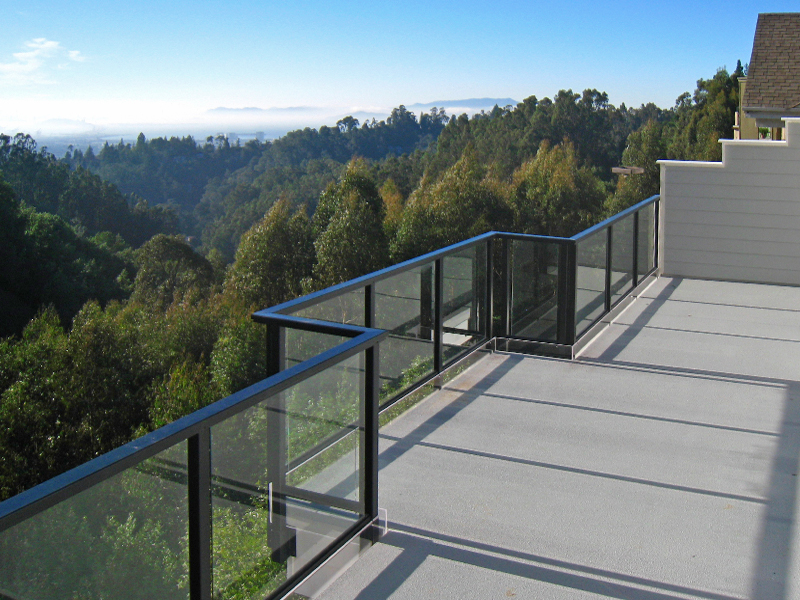
Using Glass Railings for Unobstructed Views and Windbreaks Tempered glass panels have been used as deck railings and fencing for well over 30 years. Our customers often inquire about the durability and maintenance requirements for glass railings vs. other railing types. This month we met with our preferred installers from SD Independent to weigh in on some of the pros and cons of choosing a glass railing for your deck : -What are some of the greatest benefits to installing a glass railing system? Glass panels that are framed in aluminum, stainless steel or Ipe’ are basically indestructible. Many a deck demolition job has shown us that the tempered glass panels often outlast the decking and framing materials. Glass is also completely transparent and tempered glass panels are very sturdy and safe. -What is the ideal application for a glass railing system? Our favorite glass installation jobs are usually outdoor living spaces with direct exposure. Usually outdoor dining areas or hot tub enclosures. Glass is an awesome wind break and there are so many cool and minimalistic ways to install it. If a customer wants some privacy out of the railings we will usually install frosted glass. -How does the pricing of glass compare to other railing types? Glass railings are comparable in cost to other high quality railing systems like cable railings and ornamental steel railings. There are many ways to construct glass railings and wood framing will usually be the most cost effective; followed by aluminum and stainless steel. -Are glass railings DIY friendly? They can be. Feeney design rail kits are a pretty straightforward installation for level rail applications. Interior railings, stairs and other custom situations are more advanced and will most times require a professional. -What are some of the cons associated with glass railings? Glass panels look best when they are kept clean so the biggest negative feedback we hear associated with glass is the cleaning. As a deck builder I think wooden and composite railings require much more maintenance over the long haul but regular cleaning is necessary to keep the glass panels and components looking their best. -Are there any other ideas about glass railings you may have that would help our customers? Make sure to install tempered glass panels regardless of the thickness chosen. Also, choose a proven manufacturer or build a sturdy frame from high quality materials and your glass railings will last for a very long time. San Diego Cable Railings provides fabrication and installation of custom glass railing systems as well as Designrail products by Feeney Inc. If you would like to get an estimate for one of our modern and durable railing systems please visit the quote request page.
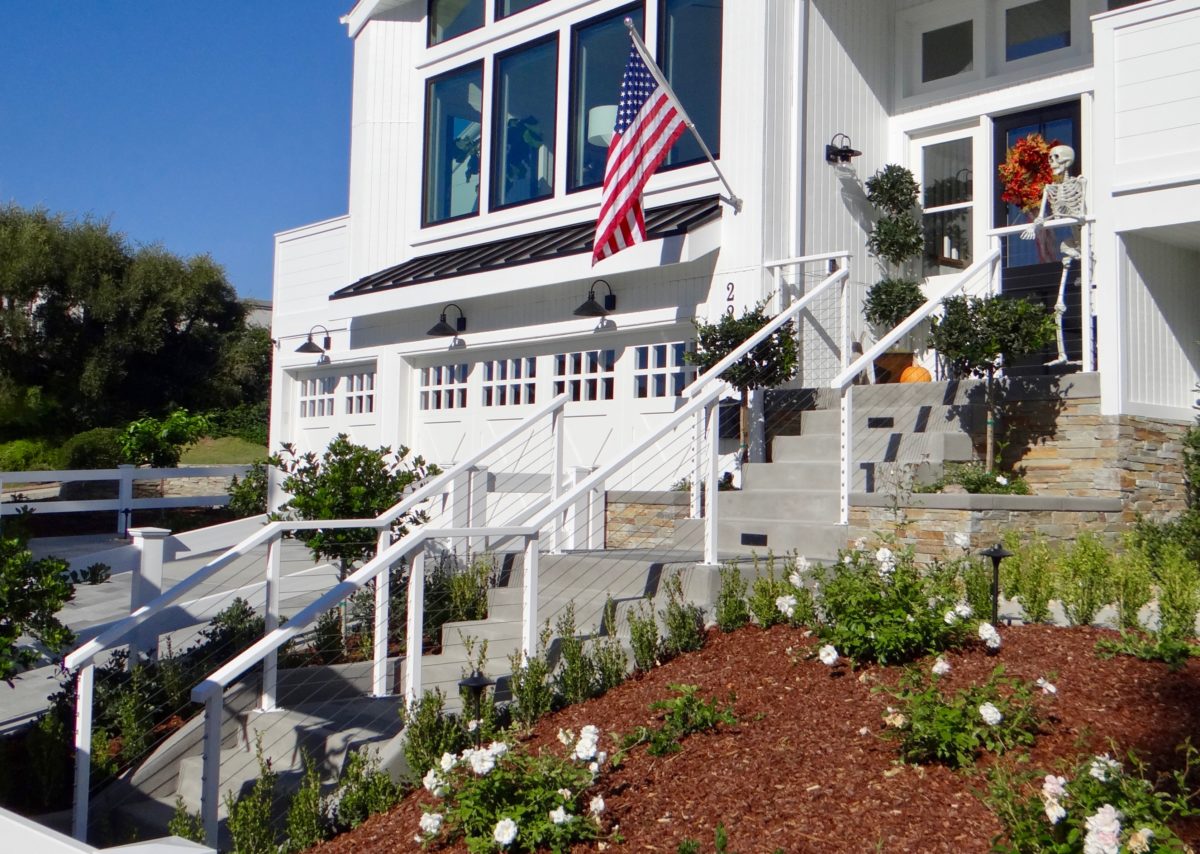
Using Stainless Steel Cable Railings for Attractive and Code Compliant Stairways Whether your budget permits for a rebuild or a remodel, stairs are an important part of any renovation. If you’re looking for a way to upgrade your stairs, or remove years from the appearance of your home; a cable railing system may be the answer. Stairways are commonly a focal point inside the home and many times one of the first things visible upon entering. Don’t forget the stairs! If you’re ready to remodel your interior or exterior stairways, our products can help. We furnish pre-drilled and pre-finished stair posts that arrive to your home ready to be installed. The angles are determined prior to fabrication for a perfect fit and easy install. All of the necessary attachment hardware is included. Welded connections and state of the art coatings make these posts an unbeatable option for remodeling stairways. Selecting top railings and/or installing graspable railings is also a breeze with our pre-finished railing materials and custom fitted parts. We offer wooden, stainless steel and aluminum options for stair railings. Customers can mix and match materials to create hybrid railings and unique looks. By providing us with a simple line drawing or photograph and dimensions we can return an estimate within 24 hours. Stainless cable assemblies for your stairs are made simple with DIY cable assemblies that do not require any special tools. Stainless cable is sleek and easy to maintain, additionally offering safety and security for your family and pets. All of our cable assemblies feature the corrosion resistance of T316 stainless and a breaking strength per cable that exceeds 1800 lbs! If DIY projects aren’t your preference, our cable railing installers are the best in the industry. We can provide quotes for both materials and installation by licensed, insured contractors with over a decade of specialized cable railing experience. Give us a call at 844-277-7327 or visit the quote request page and get a free estimate today!
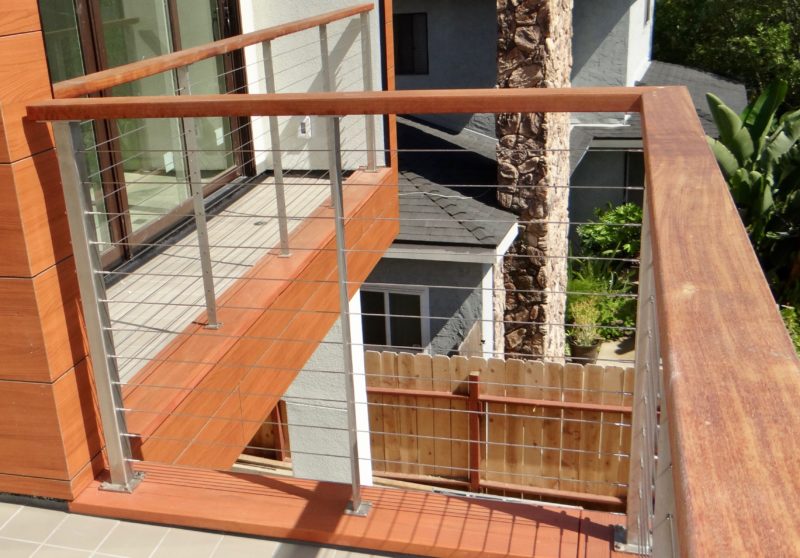
Which top railing options are best suited for my project? Selecting materials and colors for a deck or fencing project can be fun; however having a large variety of options can also make our choices more difficult. As with any home improvement project, when selecting top rails we should always consider what kind of look and feel we are trying to create. When it comes to top railing options, some of the most common topics for questions from our customers are about: Colors- Metallic finishes and dark colors like charcoal and black are widely used for modern color selections. Muted colors, earth tones, and bare mill finishes will be more commonly found on coastal applications and landscapes. White is a good choice for matching interior trim but should be used sparingly for exteriors. Size- Minimalist designs are very popular and many times the leanest top rail profiles are the most desirable. Consumers and contractors alike need to weigh the pros and cons of going thin with top railings. Cable railings need rigid frames to withstand cable tension. Consider using steel members if you want thinner top rails. When using wood timbers, try to stay with hardwood species at a minimum thickness of 1.5″. Material Choices- At SDCR we offer a broad selection of top railing materials to include: aluminum, steel, stainless steel, and a variety of wood types. In general, steel railings will provide a more industrial or modern look. Wood can assert a more neutral feel which will offer versatility when dealing with an older home. Price Points- Wood will almost always be less expensive than steel when it comes to top railing choices. For a DIY installer, wood products will also be more forgiving and require fewer tools. Steel or stainless steel top rails will typically be stronger and more durable, but they also carry a higher price point. Our company offers modular parts for both wooden and steel top railing options. We are happy to discuss these options in order to find you the best most cost effective solution for your project. Questions??? Click HERE to visit the quote request page.
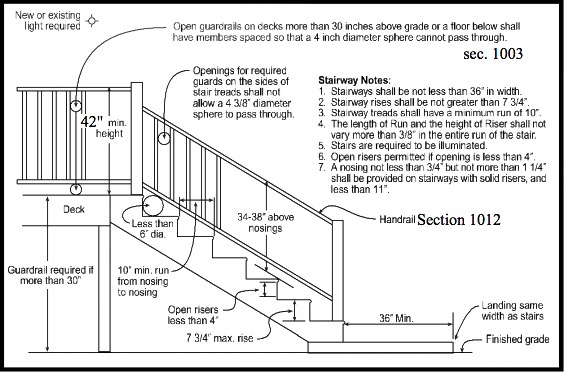
Understanding Railing Codes for Decks and Stairs As a general rule all decks higher than 30″ above grade are required to have a guardrail. If a property owner or contractor elects to install railings on any deck lower than 30″, the railings must still meet code. Deck railing height standards can vary from state to state but typically require a 36″ or 42″ railing. In California, deck railings are required to be a minimum of 42″ tall measured from the deck surface to the top of the guardrail. In addition, this measurement should be calculated from native grade; meaning adding loose fill to change grade elevation would not satisfy this requirement. Typical loading requirements dictate that guardrails should be strong enough to withstand 200 pounds of force applied anywhere along the top rail. A variety of infill options are allowed as long as the openings do not allow the passage of a 4″ sphere through the infill. Posts should be spaced no more than 6 feet apart for picket railings, and no more than 4 feet apart for cable style railings. Post spacing for glass panel railings is recommended at a maximum of 5 feet spacing. Any space between the deck surface and bottom rail member (sweep space) should not exceed 4″. Deck Railing Code Requirements for Stairways Guardrails are also required for stairways. The railing height for stairs is measured from the nose of the stair treads and must be installed between 34″ and 38″. Guard rails are different from graspable rails (grab rails) and one or both may be needed in order to satisfy code requirements. For example: a flat 2×4″ top rail will satisfy a guardrail requirement but is not acceptable for a graspable rail. Installers should be mindful of clear spacing rules for graspable rails which must allow 1.5″ of space between the guardrail or any wall surface. Additionally, the ends of graspable rails must be returned and/or terminated at railing posts. The bottom rail on any stair railing should not allow passage of a sphere greater than 6″ in diameter to pass through the triangular opening created by the stair riser. San Diego Cable Railings offers nationwide shipping and code compliant products designed for deck railings and stairs. Visit the quote request page or give us a call at 844-277-7327 to learn more about deck railing code requirements.
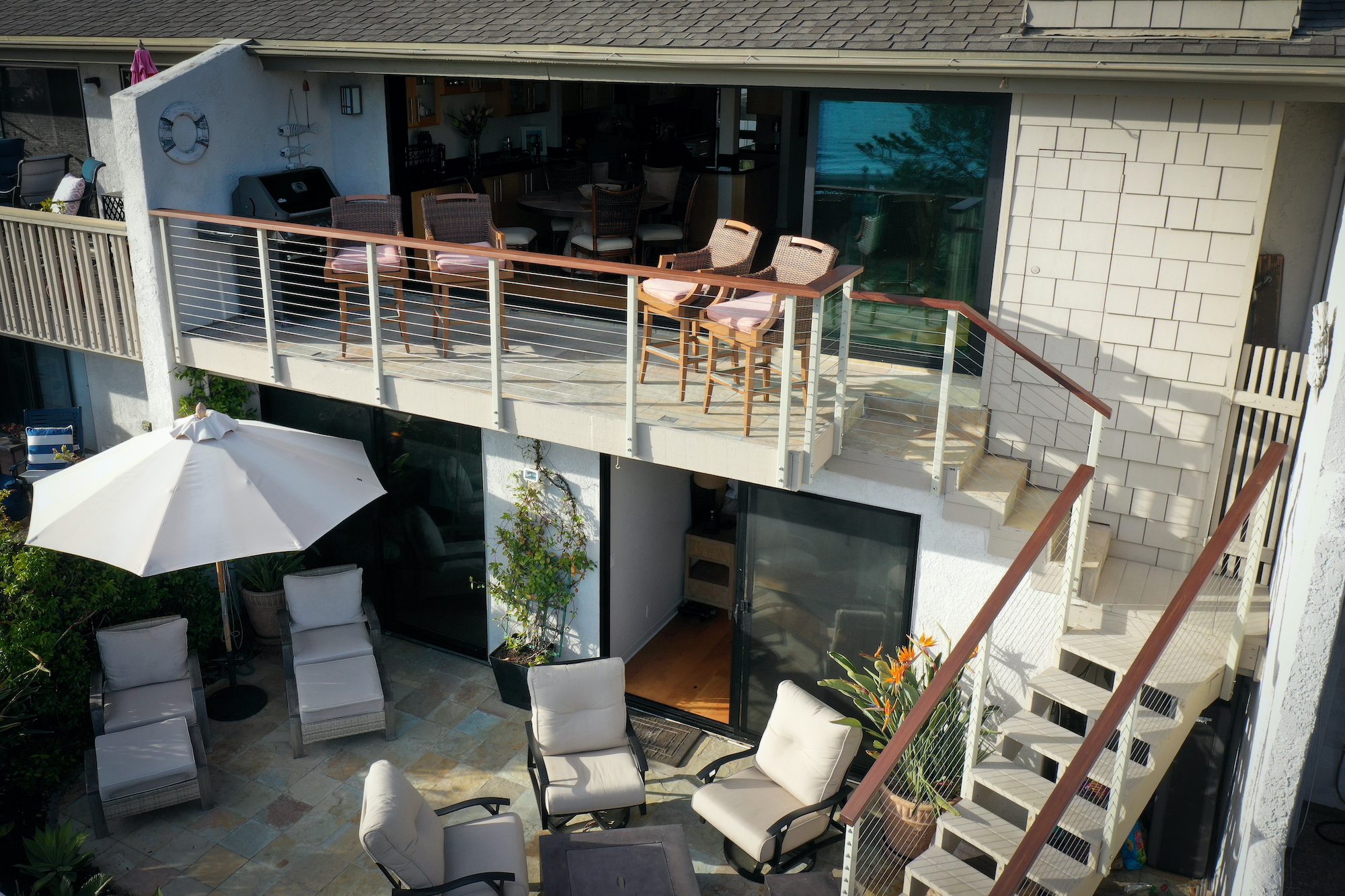
Professional Tips and Infill Options for Retrofitting Existing Railings If the structural components on your existing deck are still sound it may be a good candidate for a retrofit vs. a complete rebuild. Retrofit railings utilize existing structural members combined with new railing infill for an updated look. Below are some suggestions provided by our railing pros to help you decide if your railings are suitable for a retrofit vs. a rebuild: Evaluate Posts and Railing Members- 4″x4″ wood posts are most commonly encountered on wooden decks. Using existing wood posts is feasible for glass panels or stainless cable infill if the members are in good shape and will meet current codes. In California, the net railing height needs to be 42″ tall for barrier railings. Glass railing panels can be added to existing posts by utilizing steel clips or by picture framing the glass with wood trim. Stainless steel cable assemblies can be added to existing railing posts as long as the post spacing does not exceed 4 feet and the connections are suitable for railing tension. Inspect the railing members for signs of rot and insect damage prior to performing any retrofit work. Evaluating the age and exposure levels can also be helpful when deciding whether to retrofit or rebuild. If minor (aesthetic) blemishes are present, perform any patch work, painting or staining prior to installing new railing infill. Railing posts need to withstand a lateral pressure load of 200-250 lbs. A drilling template can be used to drill existing wooden posts for stainless cable infill. When dealing with existing structures, consulting a professional prior to performing any work is always recommended. San Diego Cable Railings can provide all necessary hardware, glass panels and/or cable infill options for retrofitting existing railings. We also offer turn key installation services by our licensed and insured preferred contractors. To find out more information, or to get an estimate on railing products please visit the quote request page.
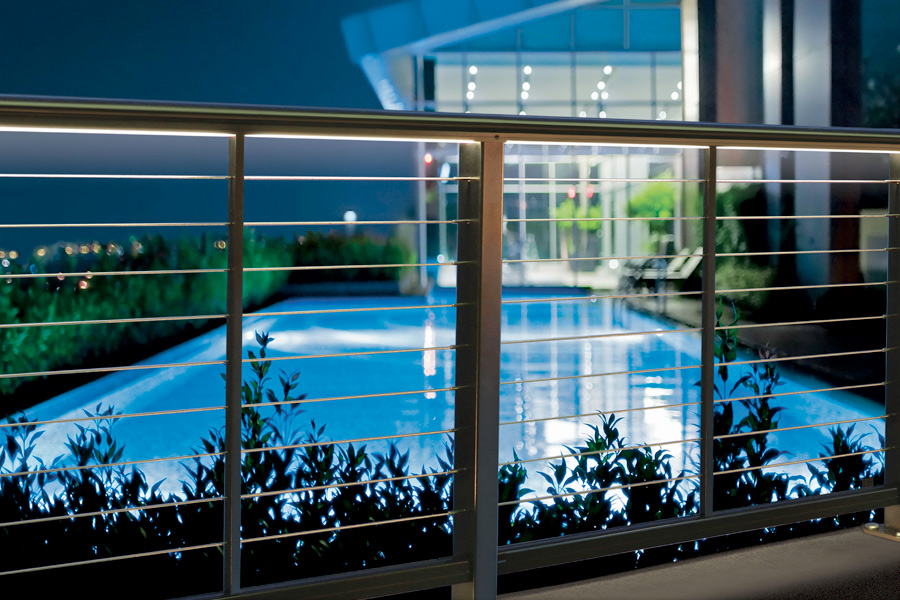
California Requirements for Safe and Code Compliant Pool Fencing Pool fencing requirements in California cover any type of pool, in ground or portable that contains over 18 inches of water. Home owners are required to construct barriers between their home and pool as a required safety measure. Technically a jacuzzi or even a portable pool purchased at a box store can fall under these guidelines. Pool fencing requirements in California are attempting to save lives; but at times this can come at the expense of aesthetics. Can I use cable railings for pool fencing in California? Stainless steel cable gates and fences can both be a viable option for pool barriers in California. Cable fences are attractive and nearly transparent; they will not cause the visible obstructions of standard pool fences. Pool barriers do have some specific requirements to note that include one or more of the following safety measures: The height of the fence has to be a minimum of 60 inches The gaps in between members cannot allow a 4″ sphere to pass through the fence Gates should be self latching and/or self closing Pools and/or spas should have approved safety covers Doors that give direct access to the pool should have exit alarms Additional requirements can be found at your local county websites like the one cited HERE. San Diego Cable Railings offers a wide variety of products to satisfy pool fencing requirements. Our durable stainless steel product line works great for coastal fencing projects as well as saline pools with salt air exposure. Additionally, we are an authorized dealer of all Feeney aluminum cable rail and design rail systems. Our preferred installers have performed code compliant cable fencing installations up and down the coast of California. If you would like to learn more about pool fencing, or to get an estimate for products and installation please visit the quote request page or call 844-277-7327.
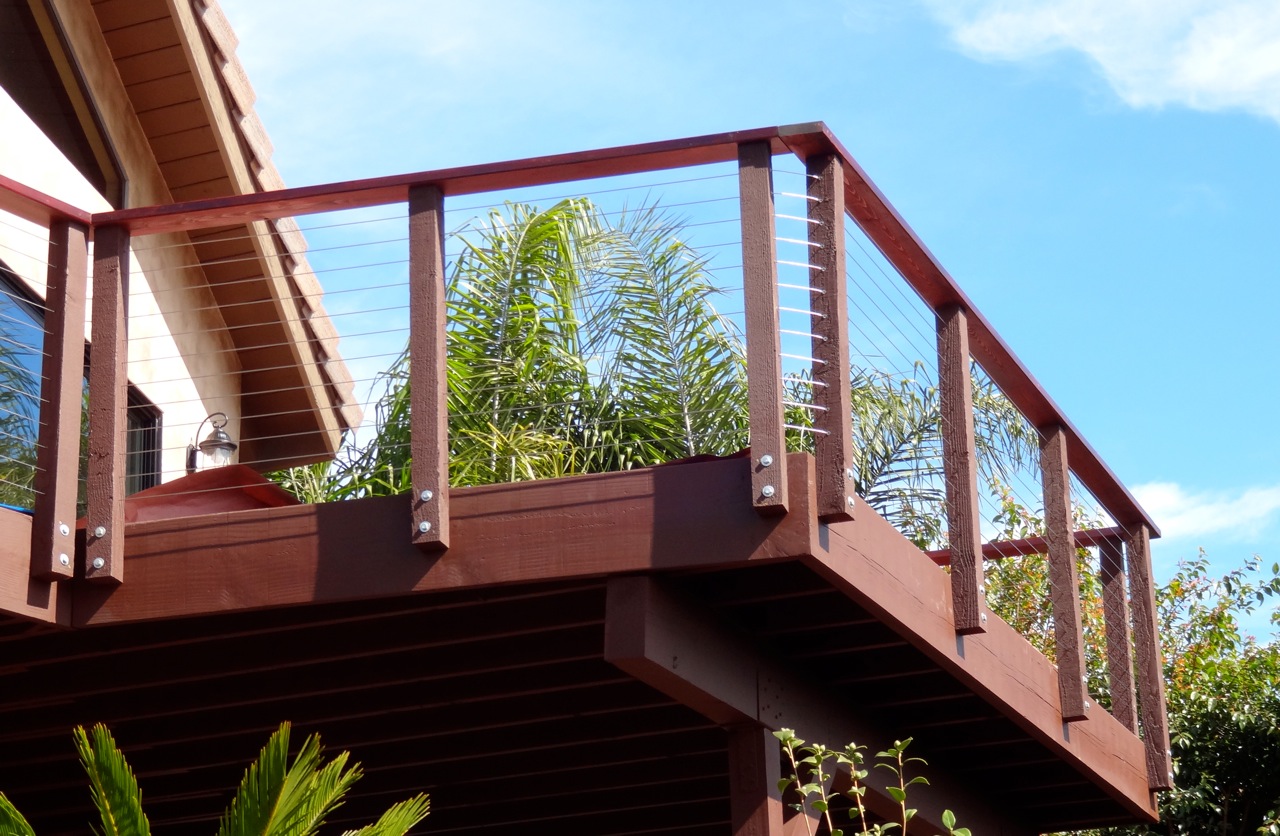
Pro Tips to Cut Your Hardware Cost and Save Money on Cable Railings If you’re looking to lower your cost on a deck railing this summer, check out the tips from our cable railing pros. Cable rail construction doesn’t have do be expensive nor do you need to sacrifice professional results to lower your cost. Anybody can save money on cable railings with a little pre-planning, proper layout and the right material choices: Use wooden posts and railing members- Wood timbers will almost always be less expensive than aluminum, steel and stainless steel. Exotic hardwoods can be an exception in certain cases however using cable railing frames made from Cedar, Fir or Redwood can cut the cost of your cable railing considerably. Pre-made wooden cable railing posts can be up to 50% less expensive than steel post alternatives. Maximize the useable spans of the hardware- Read up on the manufacturers recommendations for post spans and cable hardware. Extra fittings can greatly increase your cable cost so keep the hardware counts down whenever possible. Certain types of fittings like turnbuckles can increase your cable cost. Let the functionality of the project dictate the hardware application vs. focusing on the look of individual fittings. Use a wood top rail with steel posts- Even an exotic hardwood top rail will come at a lower premium than many steel top rail options. Additionally, the combination of steel posts and wood top rail can be made to conform to several different design styles. For example, a weathered wood top rail on steel posts can give rustic appeal with clean lines. Wooden top rails are versatile and readily available as well as DIY friendly. Consider a 2 post corner design- Using double posts at a 90 degree corner can cut your cable cost considerably. Cable cost is primarily in the fittings so running your cable the maximum recommended distance is a must. Turning the corner allows you to maximize the distance of the cable run and minimize the amount of necessary fittings. If you’re looking to save time and money on a cable railing project, visit the quote request or give our pros a call @ 844-277-7327
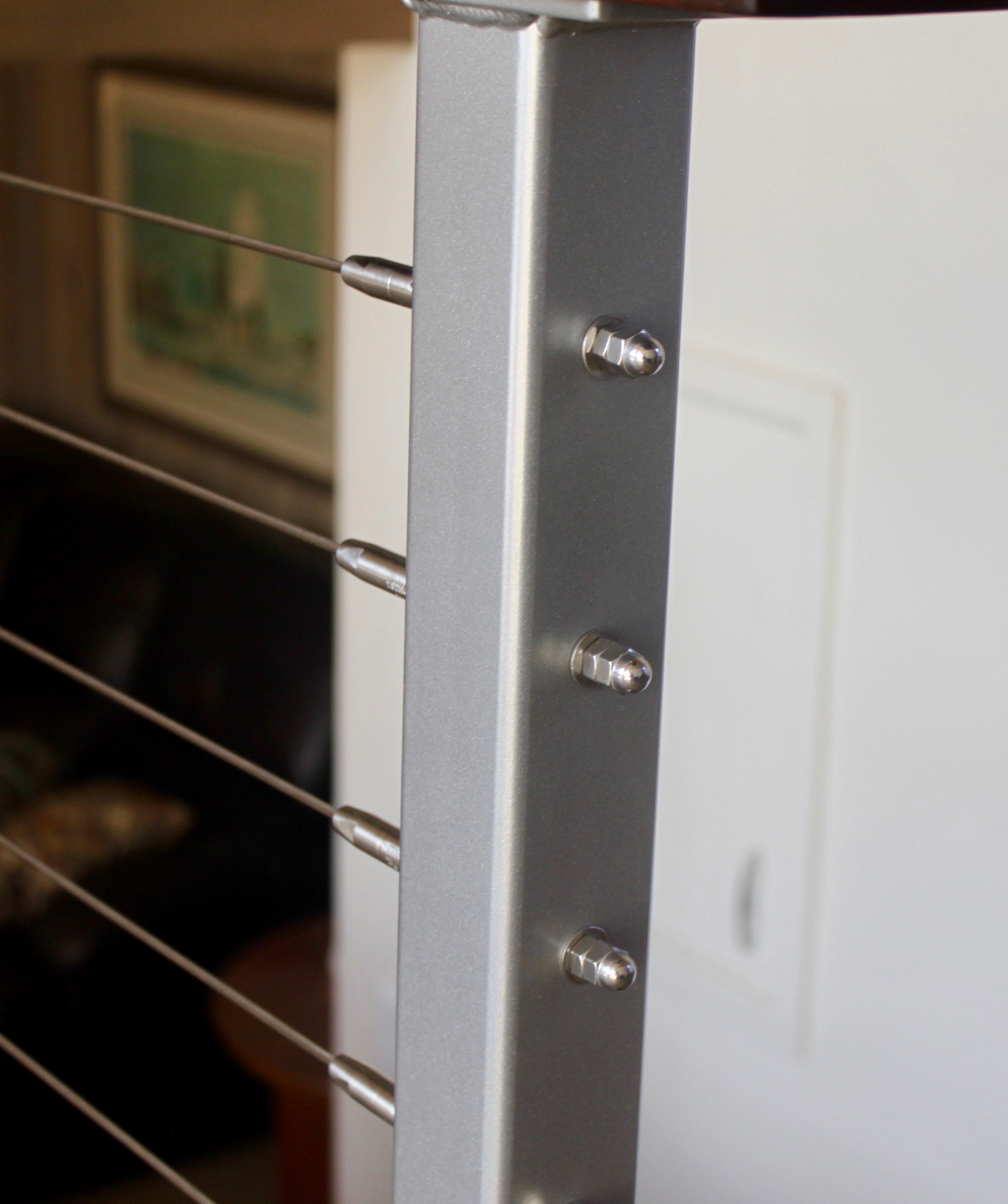
Benefits of Powder Coated Finishes for Aluminum and Stainless Steel For more than 50 years powder coating has been a popular process for enhanced aesthetics and protection of metal surfaces. Powder coated finishes are used in almost every major manufacturing industry; most commonly furniture, architecture and automotive industries to name a few. The popularity of powder coating is largely credited to the durability as well as the wide range of colors and textures available. The powder coating process begins with surface preparation that involves cleaning the metal pieces to remove any grease or contaminants. The surfaces are then lightly sandblasted or etched in order to bond with the powder during the curing process. Powder coating is applied to the desired surfaces and then cured by baking at high temperature. The end result is a smooth coating that resembles a hard protective shell that is superior to paint. Examples listed below: -Durability- Because powder coated finishes utilize a thermal bonding process, they are more resistant to chemicals, cleaners, scratching and chipping. Powders do not drip or run, resulting in a more even finish than those provided by paint. -Versatility- There are literally hundreds if not thousands of options for powder coat colors and textures. At SDCR we use state of the art coatings by companies like Tiger and Cardinal in order to offer our customers the best that the industry has to offer. -Safety- Powder coated finishes do not contain solvents and are generally free of VOC’s (volatile organic compounds). Many of the fire and health hazards that exist with paint are not associated with powder. San Diego Cable Railings offers powder coated finishes on all of our most popular railing posts and top rails. Our company offers galvanized, stainless steel, and aluminum framing systems that can be coated for interior or exterior use. If you have questions about our stock powder coated colors would like an estimate for a custom color please visit the quote request page.